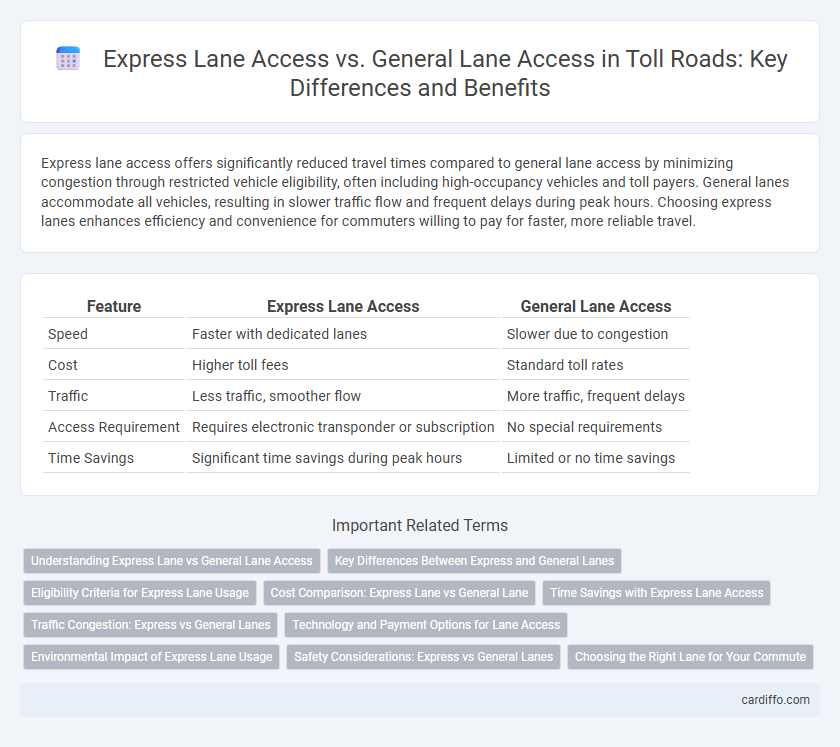Express lane access offers significantly reduced travel times compared to general lane access by minimizing congestion through restricted vehicle eligibility, often including high-occupancy vehicles and toll payers. General lanes accommodate all vehicles, resulting in slower traffic flow and frequent delays during peak hours. Choosing express lanes enhances efficiency and convenience for commuters willing to pay for faster, more reliable travel.
Table of Comparison
| Feature | Express Lane Access | General Lane Access |
|---|---|---|
| Speed | Faster with dedicated lanes | Slower due to congestion |
| Cost | Higher toll fees | Standard toll rates |
| Traffic | Less traffic, smoother flow | More traffic, frequent delays |
| Access Requirement | Requires electronic transponder or subscription | No special requirements |
| Time Savings | Significant time savings during peak hours | Limited or no time savings |
Understanding Express Lane vs General Lane Access
Express lanes provide faster travel by allowing vehicles to bypass congestion in general lanes, typically through toll payments or eligibility criteria such as carpool status. General lanes accommodate all vehicles without toll requirements but often experience heavier traffic and slower speeds. Understanding the trade-offs between express lane access and general lane access helps drivers optimize travel time and manage toll costs effectively.
Key Differences Between Express and General Lanes
Express lanes offer faster travel by limiting access to specific vehicles, often requiring a toll or electronic pass, while general lanes remain open to all drivers without additional fees. Express lanes maintain lower congestion through controlled entry, enhancing travel time reliability compared to the typically slower, more crowded general lanes. The toll rates in express lanes vary dynamically based on real-time traffic conditions, contrasting with free usage in general lanes that can lead to unpredictable delays.
Eligibility Criteria for Express Lane Usage
Express lane access eligibility typically requires vehicle occupancy minimums, such as two or more passengers, or participation in high-occupancy vehicle (HOV) programs. Certain clean-fuel vehicles and registered carpools may also qualify for reduced toll rates or free entry. Verification methods include transponder identification or periodic occupancy checks to ensure compliance with express lane criteria.
Cost Comparison: Express Lane vs General Lane
Express lane access typically involves a variable toll fee that adjusts based on traffic congestion, resulting in higher costs during peak hours but faster travel times. General lane access does not incur additional tolls, offering a cost-saving benefit but often leading to increased travel time due to congestion. The cost comparison reveals that express lanes prioritize time efficiency with premium pricing, while general lanes provide economical options with potential delays.
Time Savings with Express Lane Access
Express lane access significantly reduces travel time by minimizing congestion and allowing vehicles to bypass slower general lanes. Studies show drivers using express lanes can save up to 30% of their commute time during peak hours. This time efficiency boosts overall traffic flow and enhances daily productivity for regular commuters.
Traffic Congestion: Express vs General Lanes
Express lanes significantly reduce traffic congestion by limiting access to vehicles that meet specific criteria such as high occupancy or toll payment, allowing smoother and faster travel compared to general lanes. General lanes often experience higher vehicle density and slower speeds due to unrestricted access, resulting in frequent stop-and-go traffic and longer commute times. Data from urban toll systems indicate that express lanes can improve average travel speed by up to 30%, alleviating congestion on heavily trafficked routes.
Technology and Payment Options for Lane Access
Express lane access utilizes advanced electronic toll collection systems such as RFID and license plate recognition to enable seamless, contactless payment, reducing congestion and wait times. General lanes often rely on manual toll booths or cash payment methods, which can cause delays and slower processing speed. Mobile payment apps and automated toll readers are becoming increasingly integrated into both lane types, enhancing convenience and accuracy in toll transactions.
Environmental Impact of Express Lane Usage
Express lane access reduces idling time and congestion by promoting smoother traffic flow, which lowers vehicle emissions compared to general lanes. Vehicles in express lanes typically experience less stop-and-go driving, resulting in reduced carbon dioxide and nitrogen oxide output. By optimizing traffic efficiency, express lanes contribute to decreased air pollution and improved urban air quality.
Safety Considerations: Express vs General Lanes
Express lanes feature controlled entry points and lower congestion levels, reducing the risk of collisions compared to general lanes where frequent merging and lane changes increase accident potential. Advanced monitoring systems and toll enforcement in express lanes enhance driver compliance and safety, whereas general lanes experience more unpredictable traffic patterns and delayed incident responses. Data shows that express lanes contribute to smoother traffic flow and fewer rear-end collisions, emphasizing their safety advantages over general lanes.
Choosing the Right Lane for Your Commute
Choosing the right lane for your commute involves weighing the benefits of express lane access against general lane usage. Express lanes offer faster travel times by reducing congestion and are often toll-based, which can be more cost-effective for frequent commuters seeking time savings. General lanes provide free access but typically experience higher traffic volumes, making them less reliable during peak hours.
Express lane access vs general lane access Infographic

 cardiffo.com
cardiffo.com